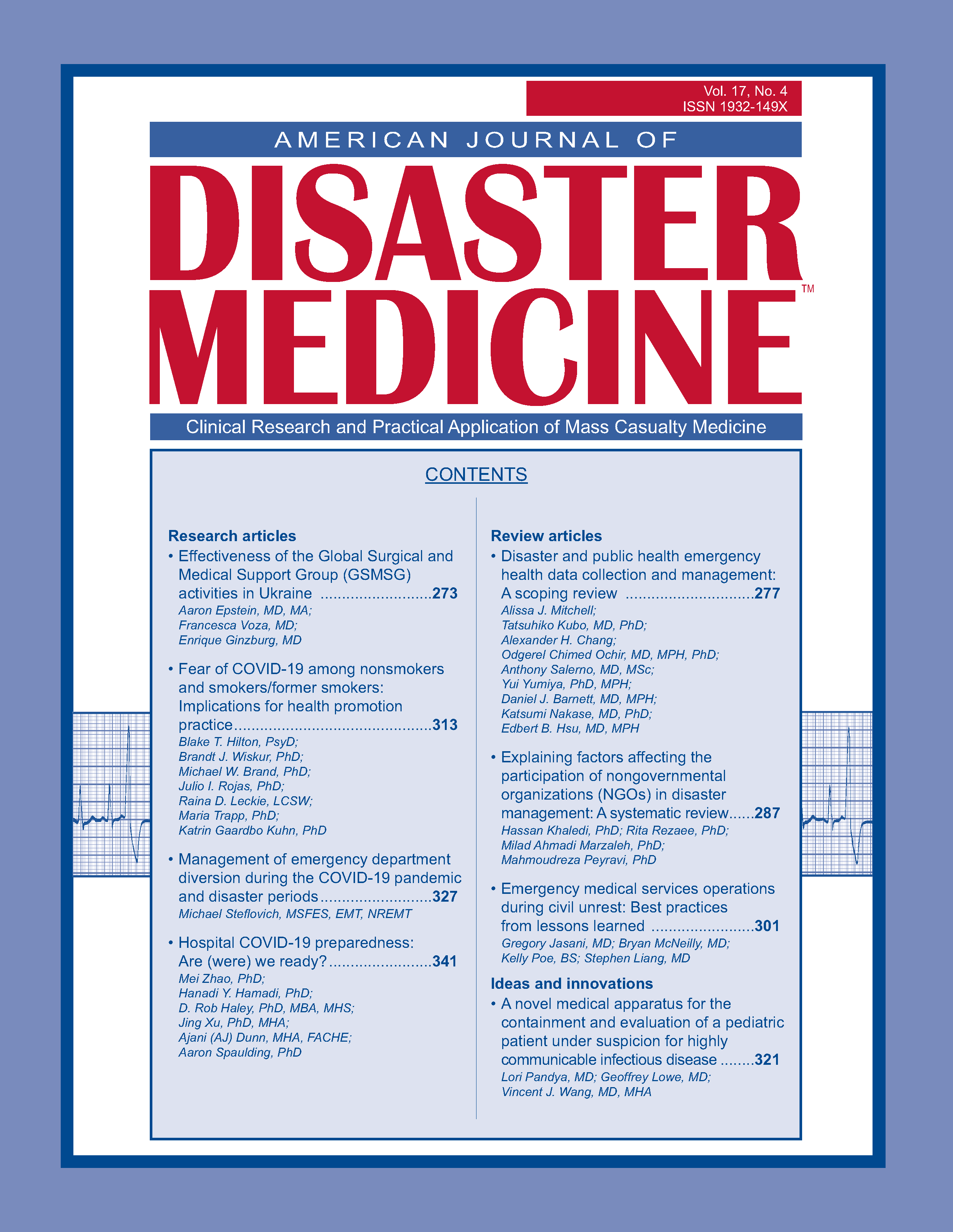Management of emergency department diversion during the COVID-19 pandemic and disaster periods
DOI:
https://doi.org/10.5055/ajdm.2022.0448Keywords:
ambulance diversion, EMS, hospital diversionAbstract
Background: Recent news has shown the strain on hospital emergency departments (EDs) and emergency medical services agencies due to the surge of COVID-19; however, compared to all emergency medical service transports, is it true that the United States is seeing an increase in the frequency of diversions? In this quantitative research report, data were collected and analyzed from a national prehospital emergency medical services information system, which allowed for a comparison of the frequency of diverted ambulances, transport times, and final patient acuity of patients arriving by diverted ambulances before and during the COVID-19 pandemic. Statistical analysis was performed on data obtained from the National Emergency Medical Services Information System to compare the frequency of ambulance diversion prior to the COVID-19 disaster and during COVID-19.
Findings: Analysis of data obtained from the National Emergency Medical Services Information System found that there was not a significant increase in the percentage of ambulance transports that were diverted during the COVID-19 pandemic compared to before the pandemic. However, there were significant increases in the volume of all transports and diverted transports during the COVID-19 pandemic (p < 0.01 for both measures).
Conclusion: The significant increases seen in the demand for services, combined with an overall downward trend in the number of healthcare facilities, have resulted in an increase in the volume of diversions, despite the overall demand increasing as well. The COVID-19 pandemic serves as a disaster/public health crisis that is subject to the same phases compared to other types of disasters. The significant findings of this report should provide the emergency services field a big picture, understanding that the problem at hand is multifaceted, with these findings shining light on the effects of current issues between emergency services and hospital EDs.
References
Bazzoll GJ, Brewster LR, Liu G, et al.: Does US hospital capacity need to be expanded. Health Affairs. 2003; 22(6): 40-54.
Centers for Disease Control and Prevention: QuickStats: Percentage of hospital emergency departments (EDs) having to divert ambulances, by selected characteristics—United States. 2003. MMWR. 2006; 55(13): 372.
Cooney DR, Millin MG, Carter A, et al.: Ambulance diversion and emergency department offload delay: Resource document for the national association of EMS physicians policy statement. Prehosp Emerg Care. 2011; 15(4): 555-561.
Florida Department of Health: Department of health announces two presumptive positive COVID-19 cases in Florida. Florida Department of Health. 2020. Available at http://www.floridahealth.gov/newsroom/2020/03/030120-two-presumptive-positive-covid19-cases.pr.html. Accessed July 15, 2021
Burt CW, McCaig LF, Valverde RH: Analysis of ambulance transports and diversions among US emergency departments. Ann Emerg Med. 2006; 47(4): 317-326.
Allon G, Deo S, Lin W: The impact of size and occupancy of hospital on the extent of ambulance diversion: Theory and evidence. Oper Res. 2013; 61(3): 544-562.
Burt CW, McCaig LF: Staffing, capacity, and ambulance diversion in emergency departments: United States, 2003-04. Adv Data. 2006; 376: 1-24.
Hsuan C, Hsia RY, Horwitz JR, et al.: Ambulance diversions following public hospital emergency department closures. Health Serv Res. 2019; 54(4): 870-879.
Halliday MH, Bouland AJ, Lawner BJ, et al.: The medical duty officer: An attempt to mitigate the ambulance at-hospital interval. West J Emerg Med. 2016; 17(5): 662-668.
Burke L: Ending ambulance diversion in Massachusetts. AMA J Ethics. 2010; 12(6): 483-486.
Neely KW, Norton RL, Young GP: The effect of hospital resource unavailability and ambulance diversions on the emergency medical services system. Prehosp Disaster Med. 1994; 9(3): 172-176.
Trzeciak S, Rivers EP: Emergency department overcrowding in the United States: An emerging threat to patient safety and public health. Emerg Med J. 2003; 20: 402-405.
Spoerre A: COVID surge prompts ambulance diversions in K.C. EMS World. October 16, 2020. Available at https://www.hmpgloballearningnetwork.com/site/emsworld/news/1225074/covid-surgeprompts-ambulance-diversions-kc. Accessed September 5, 2021.
National Emergency Medical Services Information System: NEMSIS data cube. Available at https://nemsis.org/view-reports/public-reports/ems-data-cube/. Accessed August 8, 2021.
Published
How to Cite
Issue
Section
License
Copyright 2007-2025, Weston Medical Publishing, LLC and American Journal of Disaster Medicine. All Rights Reserved.


